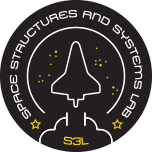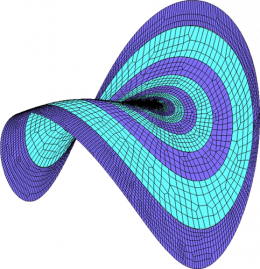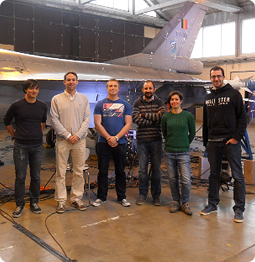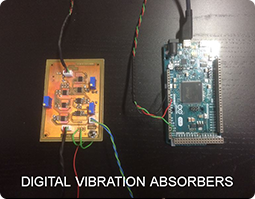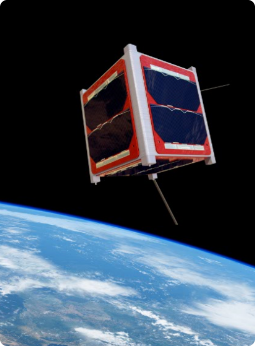Research
The research performed at S3L centers around 5 main themes:
Nonlinearity is a frequent visitor to engineering structures which can modify --- sometimes catastrophically --- their behavior. For instance, in an aircraft, besides nonlinear fluid-structure interaction, typical nonlinearities include backlash and friction in control surfaces and joints, hardening nonlinearities in the engine-to-pylon connection, and saturation effects in hydraulic actuators. Nonlinearity may give rise to complex dynamic phenomena including jumps, bifurcations, limit cycles, chaos, etc. Any attempt to apply traditional linear techniques to capture the dynamics of a structural system possessing such phenomena is bound to failure.
The objective of our research is to account for nonlinear phenomena in engineering structures instead of ignoring them as is the common practice. Specifically, our research activities focus on the development of effective methodologies for (i) nonlinear modal analysis [1,2], (ii) system identification [3,4] and (iii) bifurcation analysis [5].
Our research also intends to go one step further: it proposes not only to model nonlinearities but to take advantage of the richness and complexity of nonlinear dynamics for the design of engineering structures, for instance for vibration mitigation using nonlinear vibration absorbers [6].
Facts and figures:
- Three ERC grants on the topic of nonlinear vibrations (ERC Starting Grant: NOVIB; ERC Proof-of-Concept Grant: NI2D; ERC Advanced Grant: ENTIRE).
- Development of the Nonlinear Identification to Design (NI2D) software.
- Creation of the NOLISYS startup company which offers solutions and software for nonlinear vibrations.
- Belgian Francqui chair on Nonlinear Vibrations: From Identification to Exploitation at Vrije Universiteit Brussel.
Selected publications:
[1] Nonlinear normal modes, Part I: A useful framework for the structural dynamicist, G. Kerschen, M. Peeters, J.C. Golinval, A.F. Vakakis, Mechanical Systems and Signal Processing 23 (2009), 170-194.
[2] Numerical computation of nonlinear normal modes in mechanical engineering, L. Renson, G. Kerschen, B. Cochelin, Journal of Sound and Vibration 364 (2016), 177-206.
[3] Past, present and future of nonlinear system identification in structural dynamics, G. Kerschen, K. Worden, A.F. Vakakis, J.C. Golinval, Mechanical Systems and Signal Processing 20 (2006), 505-592.
[4] Frequency-domain subspace identification for nonlinear mechanical systems, J.P. Noel, G. Kerschen, Mechanical Systems and Signal Processing 40 (2013), 701-717.
[5] The harmonic balance method for bifurcation analysis of large-scale nonlinear mechanical systems, T. Detroux, L. Renson, L. Masset, G. Kerschen, Computer Methods in Applied Mechanics and Engineering (2015), 18-38.
[6] Nonlinear generalization of Den Hartog's equal peak method, G. Habib, T. Detroux, R. Viguié, G. Kerschen, Mechanical Systems and Signal Processing 52-53 (2015), 17-28.
The objective of our research is to account for nonlinear phenomena in engineering structures instead of ignoring them as is the common practice. Specifically, our research activities focus on the development of effective methodologies for (i) nonlinear modal analysis [1,2], (ii) system identification [3,4] and (iii) bifurcation analysis [5].
Our research also intends to go one step further: it proposes not only to model nonlinearities but to take advantage of the richness and complexity of nonlinear dynamics for the design of engineering structures, for instance for vibration mitigation using nonlinear vibration absorbers [6].
Facts and figures:
- Three ERC grants on the topic of nonlinear vibrations (ERC Starting Grant: NOVIB; ERC Proof-of-Concept Grant: NI2D; ERC Advanced Grant: ENTIRE).
- Development of the Nonlinear Identification to Design (NI2D) software.
- Creation of the NOLISYS startup company which offers solutions and software for nonlinear vibrations.
- Belgian Francqui chair on Nonlinear Vibrations: From Identification to Exploitation at Vrije Universiteit Brussel.
Selected publications:
[1] Nonlinear normal modes, Part I: A useful framework for the structural dynamicist, G. Kerschen, M. Peeters, J.C. Golinval, A.F. Vakakis, Mechanical Systems and Signal Processing 23 (2009), 170-194.
[2] Numerical computation of nonlinear normal modes in mechanical engineering, L. Renson, G. Kerschen, B. Cochelin, Journal of Sound and Vibration 364 (2016), 177-206.
[3] Past, present and future of nonlinear system identification in structural dynamics, G. Kerschen, K. Worden, A.F. Vakakis, J.C. Golinval, Mechanical Systems and Signal Processing 20 (2006), 505-592.
[4] Frequency-domain subspace identification for nonlinear mechanical systems, J.P. Noel, G. Kerschen, Mechanical Systems and Signal Processing 40 (2013), 701-717.
[5] The harmonic balance method for bifurcation analysis of large-scale nonlinear mechanical systems, T. Detroux, L. Renson, L. Masset, G. Kerschen, Computer Methods in Applied Mechanics and Engineering (2015), 18-38.
[6] Nonlinear generalization of Den Hartog's equal peak method, G. Habib, T. Detroux, R. Viguié, G. Kerschen, Mechanical Systems and Signal Processing 52-53 (2015), 17-28.
The objective of this research is to address the mechanical behaviors of aerospace structures. This research is closely linked with topic 1, as most aerospace structures exhibit nonlinear dynamical behaviors.
Facts and figures:
- Study of turbojet engines, aircraft structures, satellites and launch vehicle components.
- Collaboration with key industrial players and research centers: SAFRAN, ArianeGroup, ESA, Airbus Defence and Space [1], ONERA [2], Siemens Industry Software [3], and Liege Space Center [4].
Selected publications:
[1] Complex dynamics of a nonlinear aerospace structure: experimental identification and modal interactions, J.P. Noel, L. Renson, G. Kerschen, Journal of Sound and Vibration 333 (2014), 2588-2607.
[2] Nonlinear modal analysis of a full-scale aircraft, G. Kerschen, M. Peeters, J.C. Golinval, C. Stephan, AIAA Journal of Aircraft 50 (2013), 1409-1419.
[3] Nonlinear dynamic analysis of an F-16 aircraft using GVT data, J.P. Noel, L. Renson, G. Kerschen, B. Peeters, S. Manzato, J. Debille, International Forum of Aeroelasticity and Structural Dynamics IFASD, Bristol, UK (2013).
[4] Finite element model reduction for space thermal analysis, L. Jacques, E. Bechet, G. Kerschen, Finite Elements in Analysis and Design 127, 6-15 (2017).
Facts and figures:
- Study of turbojet engines, aircraft structures, satellites and launch vehicle components.
- Collaboration with key industrial players and research centers: SAFRAN, ArianeGroup, ESA, Airbus Defence and Space [1], ONERA [2], Siemens Industry Software [3], and Liege Space Center [4].
Selected publications:
[1] Complex dynamics of a nonlinear aerospace structure: experimental identification and modal interactions, J.P. Noel, L. Renson, G. Kerschen, Journal of Sound and Vibration 333 (2014), 2588-2607.
[2] Nonlinear modal analysis of a full-scale aircraft, G. Kerschen, M. Peeters, J.C. Golinval, C. Stephan, AIAA Journal of Aircraft 50 (2013), 1409-1419.
[3] Nonlinear dynamic analysis of an F-16 aircraft using GVT data, J.P. Noel, L. Renson, G. Kerschen, B. Peeters, S. Manzato, J. Debille, International Forum of Aeroelasticity and Structural Dynamics IFASD, Bristol, UK (2013).
[4] Finite element model reduction for space thermal analysis, L. Jacques, E. Bechet, G. Kerschen, Finite Elements in Analysis and Design 127, 6-15 (2017).
The performance of existing structures can be improved through the addition of electronics. In our research, we focus on the development of linear [1] and nonlinear piezoelectric [2,3] vibration absorbers for mitigation resonant vibrations. The electronic components are either analog or digital.
Facts and figures:
- WALinnov project on the design of a smart hybrid vibration absorber.
- Patent under preparation.
Facts and figures:
- WALinnov project on the design of a smart hybrid vibration absorber.
- Patent under preparation.
Selected publications:
[1] P. Soltani, G. Kerschen, G. Tondreau, A. Deraemaeker, Piezoelectric vibration damping using resonant shunt circuits: an exact solution, Smart Materials and Structures 23 (2014), 125014.
[2] P. Soltani, G. Kerschen, The nonlinear piezoelectric tuned vibration absorber, Smart Materials and Structures 24 (2015), 075015.
[3] B. Lossouarn, G. Kerschen, J.F. Deu, Passive realization of a nonlinear piezoelctric tuned vibration absorber with a saturable inductor, European Nonlinear Oscillations Conference (ENOC), Budapest, July 2017.
Over the years, S3L has developed expertise in the analytical and numerical propagation of satellite orbits together with uncertainty quantification [1-3]. A particular emphasis is placed on satellite orbits in the Earth's atmosphere and on orbital lifetime estimation in view of the stochastic nature of the thermosphere and the complexity of drag modeling. Another facet of our research deals with optimal control techniques applied to satellite rendezvous and formation-flying [4,5].
Facts and figures:
- ESA project on orbital lifetime estimation.
Selected publications:
[1] First-order analytic propagation of satellites in the exponential atmosphere of an oblate planet, V. Martinusi, L. Dell'Elce, G. Kerschen, Celestial Mechanics and Dynamical Astronomy 127 (2017), 451-476.
[2] Probabilistic assessment of the lifetime of low-Earth-orbit spacecraft: uncertainty characterization, L. Dell'Elce, M. Arnst, G. Kerschen, Journal of Guidance, Control and Dynamics 38 (2015), 900-912.
[3] Probabilistic assessment of the lifetime of low-Earth-orbit spacecraft: uncertainty propagation and sensitivity analysis, L. Dell'Elce, G. Kerschen, Journal of Guidance, Control and Dynamics 38 (2015), 886-899.
[4] Optimal propellantless rendez-vous using differential drag, L. Dell'Elce, G. Kerschen, Acta Astronautica 109 (2015), 112-123.
[5] Satellite formation control using continuous adaptive sliding mode controller, H. Cho, G. Kerschen, AIAA/AAS Astrodynamics Specialist Conference, Long Beach, USA 2016.
Facts and figures:
- ESA project on orbital lifetime estimation.
Selected publications:
[1] First-order analytic propagation of satellites in the exponential atmosphere of an oblate planet, V. Martinusi, L. Dell'Elce, G. Kerschen, Celestial Mechanics and Dynamical Astronomy 127 (2017), 451-476.
[2] Probabilistic assessment of the lifetime of low-Earth-orbit spacecraft: uncertainty characterization, L. Dell'Elce, M. Arnst, G. Kerschen, Journal of Guidance, Control and Dynamics 38 (2015), 900-912.
[3] Probabilistic assessment of the lifetime of low-Earth-orbit spacecraft: uncertainty propagation and sensitivity analysis, L. Dell'Elce, G. Kerschen, Journal of Guidance, Control and Dynamics 38 (2015), 886-899.
[4] Optimal propellantless rendez-vous using differential drag, L. Dell'Elce, G. Kerschen, Acta Astronautica 109 (2015), 112-123.
[5] Satellite formation control using continuous adaptive sliding mode controller, H. Cho, G. Kerschen, AIAA/AAS Astrodynamics Specialist Conference, Long Beach, USA 2016.
S3L developed the first Belgian nanosatellite, OUFTI-1, launched by the Soyuz rocket from Kourou on April 25, 2016. It is currently developing the OUFTI-NEXT nanosatellite, the mission of which is related to smart irrigation strategies of agricultural fields. More details in the education tab.
Selected publications
[1] OUFTI-1: The CubeSat developed at the University of Liège, S. Galli, J. Pisane, P. Ledent, A. Denis, J.F. Vandenrijt, P. Rochus, J. Verly, G. Kerschen, L. Halbach, 5th CubeSat Developers' Workshop, San Luis Obispo, USA (2008).
[2] Holding a technical review in an educational project: procedure implemented and lessons learned for the OUFTI-1 CubeSat, A. Denis, J. Pisane, J. Wertz, G. Kerschen, 61st International Astronautical Congress, Prague, Czech Republic (2010).
[3] [4]
Selected publications
[1] OUFTI-1: The CubeSat developed at the University of Liège, S. Galli, J. Pisane, P. Ledent, A. Denis, J.F. Vandenrijt, P. Rochus, J. Verly, G. Kerschen, L. Halbach, 5th CubeSat Developers' Workshop, San Luis Obispo, USA (2008).
[2] Holding a technical review in an educational project: procedure implemented and lessons learned for the OUFTI-1 CubeSat, A. Denis, J. Pisane, J. Wertz, G. Kerschen, 61st International Astronautical Congress, Prague, Czech Republic (2010).
[3] [4]
